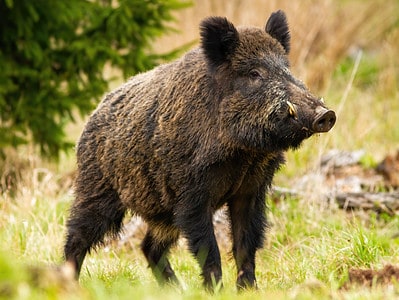Bonito Fish
Sarda
May eat squid or other small invertebrate ocean life
Advertisement
Bonito Fish Scientific Classification
- Kingdom
- Animalia
- Phylum
- Chordata
- Class
- Actinopterygii
- Order
- Scombriformes
- Family
- Scombridae
- Genus
- Sarda
- Scientific Name
- Sarda
Read our Complete Guide to Classification of Animals.
Bonito Fish Conservation Status
Bonito Fish Facts
- Prey
- Sardines and anchovies or other small fish
- Group Behavior
- School
- Fun Fact
- May eat squid or other small invertebrate ocean life
- Estimated Population Size
- Unknown due to this fish’s frequent migration patterns.
- Biggest Threat
- Overfishing for consumption
- Most Distinctive Feature
- Tuna-like appearance with stripes and varying coloration
- Other Name(s)
- Striped Bonito, Bunny, Common Bonito, Horse Mackerel, Little Bonito, Skipjack
- Gestation Period
- Eggs take 3 days to hatch.
- Habitat
- Worldwide from the open ocean to nearshore areas with kelp accumulations
- Predators
- Blue fin tuna, swordfish, marlins and other large fish
- Diet
- Carnivore
- Favorite Food
- Other small fish and invertebrate ocean life
- Type
- Schooling fish
- Number Of Species
- 4
View all of the Bonito Fish images!
The Bonito fish is a medium size, predatory fish.
Bonito Fish have stripes on their back with a silver underside. Four different species of Bonito Fish can be found across the globe.
These fish are popular with both commercial and sport fishermen. They are also used as bait to catch larger fish.

4 Incredible Bonito Facts!
- Bonitos can swim up to 40 miles per hour.
- Bonito fish are carnivorous predators. They hunt a variety of smaller fish and invertebrates.
- Some fishermen catch them to use as bait for catching larger fish.
- Bonito Fish swim in large schools.
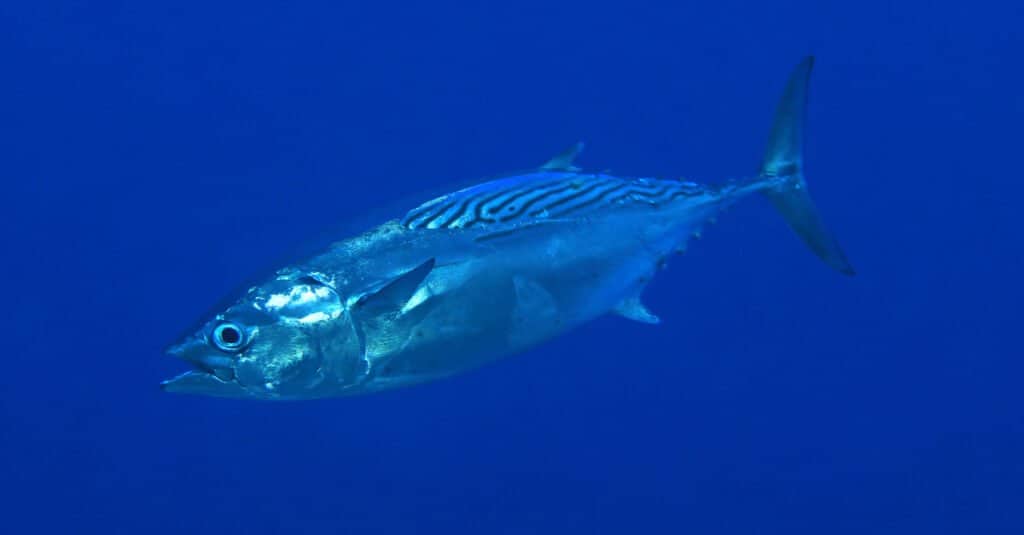
Bonitos can swim up to 40 miles per hour, and they are carnivorous predators that hunt a variety of smaller fish and invertebrates.
©aquapix/Shutterstock.com
Types and Scientific Name
There are four main species of Bonito Fish that are most commonly recognized. They are the Atlantic Bonito, the Pacific Bonito, the Indo-Pacific Bonito, and the Australian Bonito. The scientific names for these species are Sarda Sarda, Sarda Chiliensis, Sarda Orientalis, and Sarda Australis, respectively. The term Sarda refers to the genus that Bonita Fish belongs to. The second word in the scientific name for each species refers to the area where the Bonito Fish can be found.
- Atlantic Bonito – Sarda sarda – Just like the other subspecies of the Bonito, the name tells you where they can be found. These can be found in shallow waters the Atlantic Ocean, of course, but they also live inward in the Mediterranean Sea and even into the Black Sea. Their populations play a large role in commercial fishing.
- Pacific Bonito – Sarda lineolata – While there was some debate about these being a subspecies of Sarda chiliensis, they are considered gaming fish because they put up a good fight and can be found in schools ranging from as far north as the Alaskan coast and as far south as Baja California.
- Eastern Pacific Bonito – Sarda chiliensis – These can be found on the western coast of South America from Chile to Ecuador.
- Indo-Pacific Bonito – Sarda orientalis – Also known as mackerel bonito and striped bonito, these Bonitos are found swimming in the East Pacific and Indo-Pacific waters. It is not uncommon to find them swimming with schools of tuna. Their backs have narrow stripes, which helps give them one of their nicknames.
- Australian Bonito – Sarda australis – Found in the waters around Australia and New Zealand, this type of Bonito is also referred to as horse mackerel or even “little bonito. They typically do not reach more than 40 inches or 22 pounds.
These fish belong to the Scombridae family. There are 51 species in this family. Some of the other fish in this family include tuna, mackerel, and butterfly kingfish. Bonito Fish is part of the Actinopterygii class.

The
scientific names
for Bonito species are Sarda Sarda, Sarda Chiliensis, Sarda Orientalis, and Sarda Australis.
©funny face/Shutterstock.com
Appearance
These fish can grow to be up to 30 inches long. They have a more streamlined body that is similar to that of a tuna. Their backs are blue with longitudinal stripes, and their undersides are silver. A Bonito Fish’s tail is forked with a narrow base.
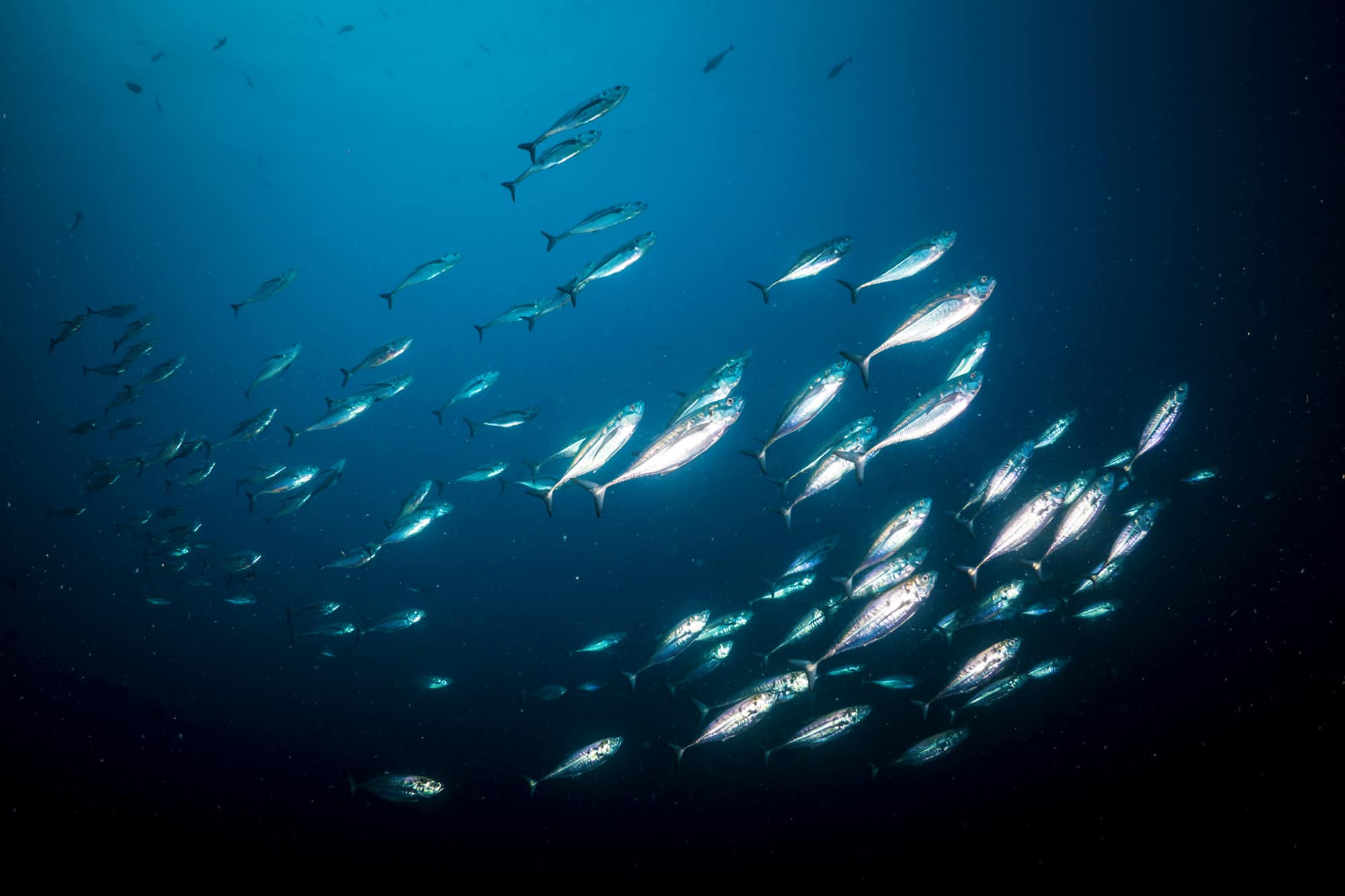
Bonito Fish have a more streamlined body that is similar to that of a tuna.
©Mike Workman/Shutterstock.com
Distribution, Population, and Habitat
The four different species are spread out in different areas of the globe. Pacific Bonitos can be found between Chile and the Gulf of Alaska, though most are located in warmer areas near southern California and Mexico.
Atlantic Bonito Fish are found between Norway and South Africa. They can also be found in the Black Sea, the Mediterranean Sea, and the northern Gulf of Mexico. Australian Bonitos are found in temperate areas near New Zealand and Australia. The Indo-Pacific Bonito’s range extends from the Gulf of California to Peru. They can also be found near the Oceanic Islands, with the exception of Clipperton.
These fish choose different areas for their habitats. Some can be found in more open water areas, whereas others frequent kelp forests that are closer to the shoreline. In general, younger fish are more common to be found closer to the shore. They may also swim into bays or harbors. Larger adult Bonitos may swim up to 300 feet below the surface.
There is not a lot of information about the total population of these fish or each individual species, but the fish is not considered to be threatened. They have a conservation status of least concern according to the International Union for Conservation of Nature.

Atlantic Bonito Fish are found between
Norway
and South Africa.
©Alessandro De Maddalena/Shutterstock.com
Predators and Prey
What Eats Them?
Bonito Fish face a lot of natural predators. Striped Marlin, Swordfish, Bluefin Tuna, and other large fish like to eat Bonitos. Additionally, marine malls like Dolphins, Pelagic Sharks, Thresher Sharks, Shortfin Mako Sharks, and Sea Lions also prey on them.
Humans also hunt Bonito Fish. They are hunted both for sport as well as commercially.
What Do They Eat?
Bonitos are predatory fish that eat other smaller fish and sea creatures. Some of their favorite foods include anchovies, squid, sardines, herring, mackerels, and shrimp. The diet of a Bonito will vary for the different species based on the other sea life that lives in the same area where they live. However, all Bonito Fish are predatory, carnivorous hunters.
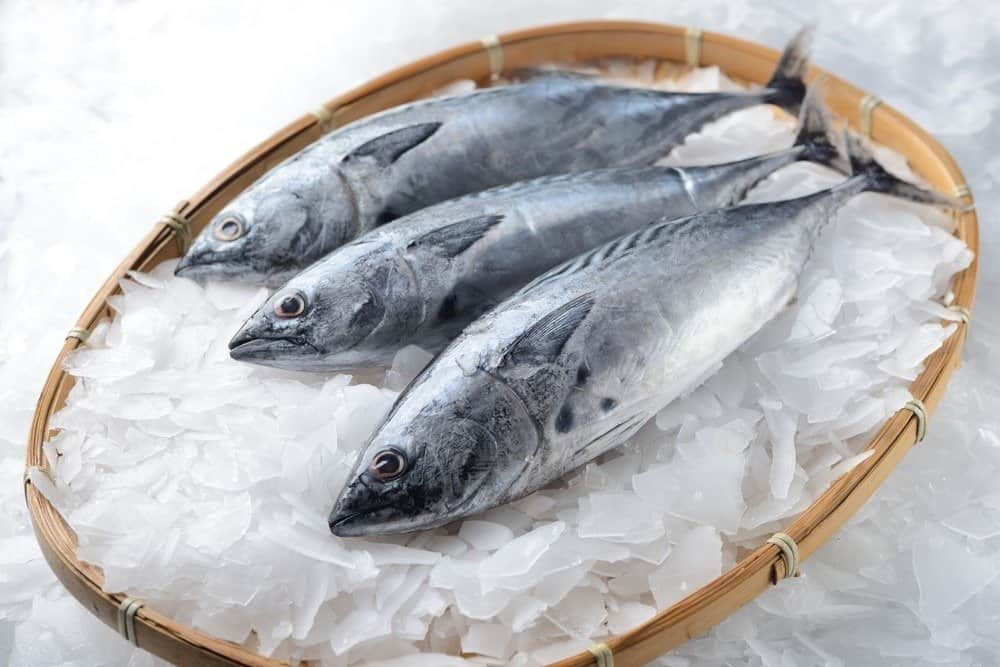
Bonito Fish are hunted both for sport as well as commercially.
©Jordan Lye/Shutterstock.com
Reproduction and Lifespan
These fish reach sexual maturity around the age of two. The time of the year when spawning occurs varies by season. For example, Atlantic Bonitos typically spawn during the summer, while Pacific Bonitos spawn between the end of January and May.
Bonitos are broadcast spawners. This means that they release the sperm and eggs (also known as gametes) into the water where they will be fertilized. After the eggs are released, neither the male nor female does anything to watch over the eggs or care for the young. Approximately three days after being released, the eggs will hatch.
Fishing and Cooking
These fish are fished both recreationally and commercially. Some people catch smaller Bonitos to use as bait for larger fish, such as mackerel. Additionally, people often share that catching a Bonito is good practice for tackle fishing. While these fish are caught all year long, more are around during the spring or summer.
These fish are sometimes used in cooking, but many people find that they have too strong of a flavor combined with an unpleasant oily texture. The meat of a Bonito is dark red.
If you would like to try these fish, here are a few recipes you can try.
• Grilled Bonito
• Smoked Bonito
• Fried Bonito with Garlic
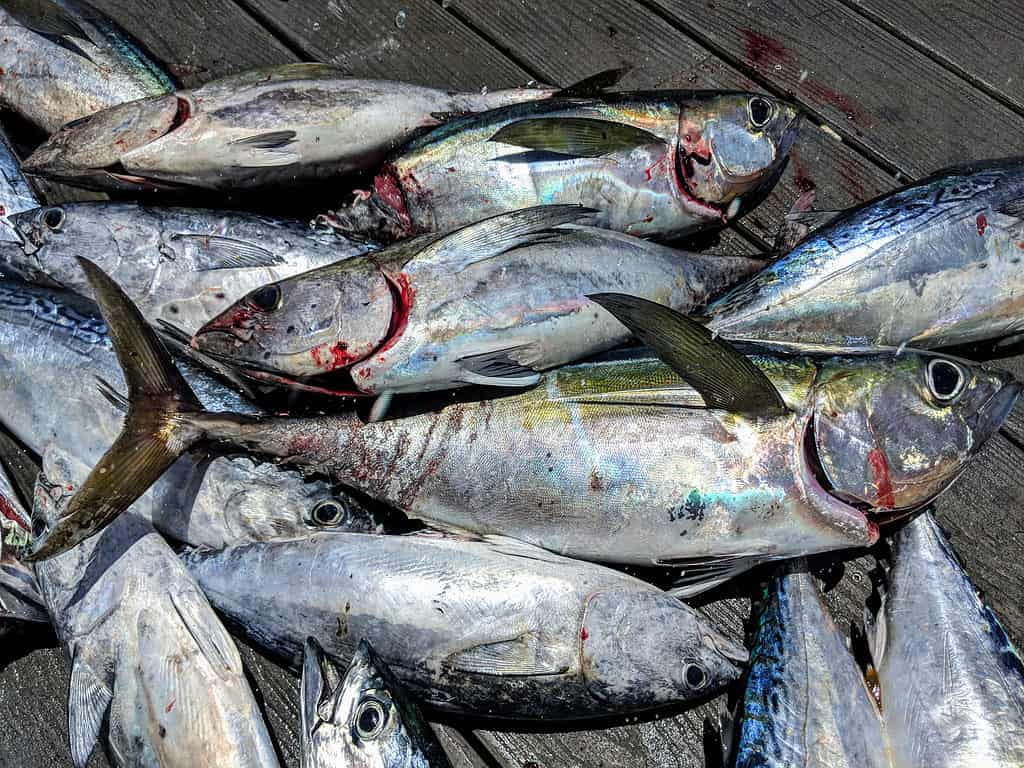
Bonito are fished both recreationally and commercially. Some people catch smaller Bonitos to use as bait for larger fish, such as mackerel.
©Millbilly Photos/Shutterstock.com
Bonito vs Bonita
While their names sound very similar, a Bonita Fish is different from a Bonito Fish. Bonitas are also in the Scombridae family. The scientific name for Bonita Fish is Euthynnus Alletturaturs. Whereas Bonito Fish are closely related to mackerels, Bonita Fish are more closely related to tuna.
View all 285 animals that start with BBonito Fish FAQs (Frequently Asked Questions)
Where are Bonito found?
The four species of Bonito Fish are found all over the world in the Atlantic Ocean, Pacific Ocean, and near Australia and New Zealand.
What is a Bonito Fish
A Bonito Fish is a predatory, carnivorous fish. They can grow to be up to 30 inches long and have a blue striped back with a silver belly.
Can you eat Bonito Fish
Yes, you can eat Bonito Fish, though some believe it is too oily and has a very strong flavor.
Is Bonito high in mercury?
As a predatory fish that prey on other fish in the ocean, Bonito Fish can contain higher levels of mercury than other fish. You will want to be careful to list the total amount that you consume.
How big do Bonito Fish get?
Bonito Fish can grow to be up to 30 inches long. They can weigh up to 25 pounds.
Are Bonito Fish herbivores, carnivores, or omnivores?
Bonito Fish are Carnivores, meaning they eat other animals.
What Kingdom do Bonito Fish belong to?
Bonito Fish belong to the Kingdom Animalia.
What phylum do Bonito Fish belong to?
Bonito Fish belong to the phylum Chordata.
What class do Bonito Fish belong to?
Bonito Fish belong to the class Actinopterygii.
What family do Bonito Fish belong to?
Bonito Fish belong to the family Scombridae.
What order to Bonito Fish belong to?
Bonito Fish belong to order Scombriformes.
What type of covering do Bonito Fish have?
Bonito Fish are covered in Scales.
What are some predators of Bonito Fish?
Predators of Bonito Fish include blue fin tuna, swordfish, marlins, and other large fish.
What is the scientific name for the Bonito Fish?
The scientific name for the Bonito Fish is Sarda.
How do Bonito Fish have babies?
Bonito Fish lay eggs.
Thank you for reading! Have some feedback for us? Contact the AZ Animals editorial team.
Sources
- Draft Marine Species Report Bonito, Available here: chrome-extension://ohfgljdgelakfkefopgklcohadegdpjf/https://opc.ca.gov/webmaster/_media_library/2019/08/Draft_Marine-Species-Report_Bonito.pdf
- Wikipedia, Available here: https://en.wikipedia.org/wiki/Bonito
- Britannica, Available here: https://www.britannica.com/animal/bonito
- Synopsis of Biological Data on Bonitos of the genus Sarda, Available here: chrome-extension://ohfgljdgelakfkefopgklcohadegdpjf/http://www.fao.org/3/ap926e/ap926e.pdf
- Thought Co, Available here: https://www.thoughtco.com/worlds-fastest-fish-2291602#:~:text=Bonito%20(40%20mph)&text=Bonito%2C%20a%20common%20name%20for,to%2030%20to%2040%20inches.
- Fishing Status, Available here: https://fishingstatus.com/fishing/species/fish/IndexID/858103#:~:text=The%20Atlantic%20bonito%20is%20a,Mexico%20in%20the%20western%20Atlantic.
- Australian Museum, Available here: https://australian.museum/learn/animals/fishes/australian-bonito-sarda-australis-macleay-1881/
- Big Water Adventures, Available here: https://www.bigwateradventures.com/fish_species_guide/bigwater_adventures_bonito.php
- Smithsonian Tropical Research Institute, Available here: https://biogeodb.stri.si.edu/sftep/en/thefishes/species/2220#:~:text=Habitat%3A%20pelagic%20in%20coastal%20and,the%20oceanic%20islands%20except%20Clipperton.
- Lure Me Fish, Available here: https://luremefish.com/bonito-fish/
- Sea Grant California, Available here: https://caseagrant.ucsd.edu/seafood-profiles/pacific-bonito#:~:text=As%20with%20other%20top%20predators,for%20pregnant%20women%20and%20children.
- The Fish Wrap Writer, Available here: https://fishwrapwriter.com/2017/08/20/local-experts-give-solid-advice-on-bonito-and-albies/











